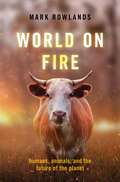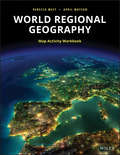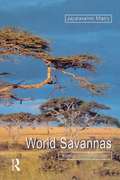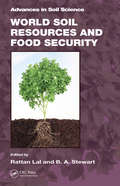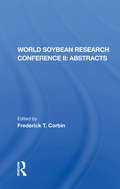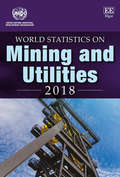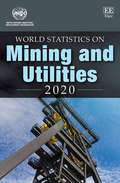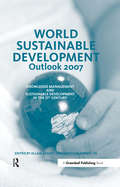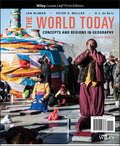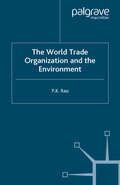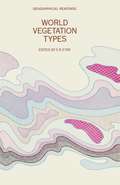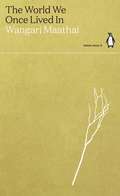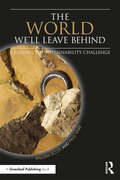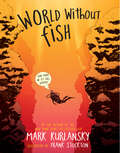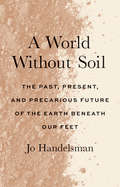- Table View
- List View
World on Fire: Humans, Animals, and the Future of the Planet
by Mark RowlandsMark Rowlands presents a novel analysis of three epoch-defining environmental problems: climate, extinction, and pestilence. Our climate is changing at a rate that is unprecedented and, if unchecked, disastrous. Species are disappearing hundreds or thousands of times faster than normal. COVID-19 has wreaked social and economic havoc but is merely the latest off a blossoming production line of emerging infectious diseases, many of which have the potential to be far worse. Rowlands establishes that all three problems are consequences of choices we have made about energy, which can be divided into two major forms: fuel and food. Focusing on food choices as far more central to the issue than commonly recognized, he argues that the solution is breaking our collective habit of eating animals. Rowlands shows that in doing so, we stem our insatiable hunger for land, which he identifies as central to the problems of extinction and pestilence. He explains that reversing the industrial farming of animals for food will first, substantially cut climate emissions, rapidly enough to allow sustainable energy technologies time to become viable alternatives; and most importantly, make vast areas of a land available for the kind of aggressive afforestation policy that he shows as necessary to bring all three problems under control. With World on Fire, Mark Rowlands identifies the source of our environmental ills and provides a compelling and accessible account of how to solve them.
World on Fire: Humans, Animals, and the Future of the Planet
by Mark RowlandsMark Rowlands presents a novel analysis of three epoch-defining environmental problems: climate, extinction, and pestilence. Our climate is changing at a rate that is unprecedented and, if unchecked, disastrous. Species are disappearing hundreds or thousands of times faster than normal. COVID-19 has wreaked social and economic havoc but is merely the latest off a blossoming production line of emerging infectious diseases, many of which have the potential to be far worse. Rowlands establishes that all three problems are consequences of choices we have made about energy, which can be divided into two major forms: fuel and food. Focusing on food choices as far more central to the issue than commonly recognized, he argues that the solution is breaking our collective habit of eating animals. Rowlands shows that in doing so, we stem our insatiable hunger for land, which he identifies as central to the problems of extinction and pestilence. He explains that reversing the industrial farming of animals for food will first, substantially cut climate emissions, rapidly enough to allow sustainable energy technologies time to become viable alternatives; and most importantly, make vast areas of a land available for the kind of aggressive afforestation policy that he shows as necessary to bring all three problems under control. With World on Fire, Mark Rowlands identifies the source of our environmental ills and provides a compelling and accessible account of how to solve them.
World Population Growth Graph (large print)
by RnibThis is a graph showing how the human population of the world has grown over the last 500 years. There is a locator dot shown, which will be at the top left of the page when the image is the correct way up. There is a grid of squares in light dotted lines on the graph. The Y-axis is on the left of the page. It is marked from zero at the bottom to seven at the top, in units of one billion. The X-axis stretches across the bottom of the page. It starts at the year 1500 AD at the origin in the bottom left of the graph and goes up to the year 2000 AD in the bottom right. The heavy dashed data line starts at less than half a billion on the left, carries on almost horizontal until 1800 AD, and then curves up sharply to the year 2000 AD.
World Population Growth Graph (UEB contracted)
by RnibThis is a graph showing how the human population of the world has grown over the last 500 years. There is a locator dot shown, which will be at the top left of the page when the image is the correct way up. There is a grid of squares in light dotted lines on the graph. The Y-axis is on the left of the page. It is marked from zero at the bottom to seven at the top, in units of one billion. The X-axis stretches across the bottom of the page. It starts at the year 1500 AD at the origin in the bottom left of the graph and goes up to the year 2000 AD in the bottom right. The heavy dashed data line starts at less than half a billion on the left, carries on almost horizontal until 1800 AD, and then curves up sharply to the year 2000 AD.
World Population Growth Graph (UEB uncontracted)
by RnibThis is a graph showing how the human population of the world has grown over the last 500 years. There is a locator dot shown, which will be at the top left of the page when the image is the correct way up. There is a grid of squares in light dotted lines on the graph. The Y-axis is on the left of the page. It is marked from zero at the bottom to seven at the top, in units of one billion. The X-axis stretches across the bottom of the page. It starts at the year 1500 AD at the origin in the bottom left of the graph and goes up to the year 2000 AD in the bottom right. The heavy dashed data line starts at less than half a billion on the left, carries on almost horizontal until 1800 AD, and then curves up sharply to the year 2000 AD.
World Population Growth (tactile)
by RnibThis is a tactile diagram for GCSE level students. It shows a graph charting population growth of the world from 1500 ad to 2000 ad. Labels and the axis help the reader to navigate the image.
World Population (tactile)
by RnibThis is a tactile diagram for GCSE level students. It consists of three pages: the first page is a key where tactile symbols and labels are explained, the second and third page shows a world map with textures indicating level of population density. Labels and textures help the reader to navigate the image.
World Regional Geography Workbook
by Rebecca West April WatsonThis workbook contains basemaps of the major realms, including: North America, Middle America, South America, Europe, Russia/Central Asia, North Africa/Southwest Asia, Subsaharan Africa, South Asia, East Asia, Southeast Asia, the Austral Realm, and the Pacific Realm. The workbook contains activities intended for use with the blank basemaps, along with assessment questions for each realm. The activities and questions will teach students to: interpret maps/be able to explain what each map shows. identify the most critical parts of any map. understand the static nature of maps. understand the difference between spatial and non-spatial data. form a much better understanding of the scale involved when maps are used. improve spatial reasoning/thinking skills. make inferences and draw conclusions about countries and regions based on information presented within maps.
World Savannas: Ecology and Human Use
by Jayalaxshm Mistry Andrea BeradiAn interdisciplinary text on the world's savannas, covering the geography, ecology, economics and politics of savanna regions. Savannas are a distinct vegetation type, covering a third of the world's land surface area and supporting a fifth of the world's population. There has been a wide range of literature on the subject, but the majority of work has focused on the ecology or development of savanna areas, ignoring the wider interdisciplinary issues affecting contemporary savannas. World Savannas aims to buck this trend, providing students with an up-to-date and comprehensive introduction to the global importance of savannas.
World Savannas: Ecology and Human Use
by Jayalaxshm Mistry Andrea BeradiAn interdisciplinary text on the world's savannas, covering the geography, ecology, economics and politics of savanna regions. Savannas are a distinct vegetation type, covering a third of the world's land surface area and supporting a fifth of the world's population. There has been a wide range of literature on the subject, but the majority of work has focused on the ecology or development of savanna areas, ignoring the wider interdisciplinary issues affecting contemporary savannas. World Savannas aims to buck this trend, providing students with an up-to-date and comprehensive introduction to the global importance of savannas.
World Soil Resources and Food Security
by Rattan Lal B. A. StewartSoil-The Basis of All Terrestrial LifeAncient civilizations and cultures-Mayan, Aztec, Mesopotamian, Indus, and Yangtze-were built on good soils, surviving only as long as soils had the capacity to support them. In the twenty-first century, productive soil is still the engine of economic development and essential to human well-being. The quality of
World Soybean Research Conference Ii, Abstracts
by Frederick T CorbinThe result of strong international interest in the soybean, the World Soybean Research Conference II was held March 26-29, 1979, at North Carolina State University. This volume contains summaries of the more than two hundred papers presented at that meeting. The authors, international authorities in their fields, represent sixteen areas of professi
World Soybean Research Conference Ii, Abstracts
by Frederick T CorbinThe result of strong international interest in the soybean, the World Soybean Research Conference II was held March 26-29, 1979, at North Carolina State University. This volume contains summaries of the more than two hundred papers presented at that meeting. The authors, international authorities in their fields, represent sixteen areas of professi
World Statistics on Mining and Utilities 2018
by UnidoWorld Statistics on Mining and Utilities 2018 provides a unique biennial overview of the role of mining and utility activities in the world economy. This extensive resource from UNIDO provides detailed time series data on the level, structure and growth of international mining and utility activities by country and sector. Country level data is clearly presented on the number of establishments, employment and output of activities such as coal, iron ore and crude petroleum mining as well as the production and supply of electricity, natural gas and water. This unique and comprehensive source of information meets the growing demand of data users who require detailed and reliable statistical information on the primary industry and energy producing sectors. The publication provides internationally comparable data for economic researchers, development strategists and business communities who influence the policy of industrial development and its environmental sustainability.
World Statistics on Mining and Utilities 2020
by UNIDOWorld Statistics on Mining and Utilities 2020 provides a unique biennial overview of the role of mining and utility activities in the world economy. This extensive resource from UNIDO provides detailed time series data on the level, structure and growth of international mining and utility activities by country and sector. Country level data is clearly presented on the number of establishments, employment and output of activities such as coal, iron ore and crude petroleum mining as well as the production and supply of electricity, natural gas and water. This unique and comprehensive source of information meets the growing demand of data users who require detailed and reliable statistical information on the primary industry and energy producing sectors. The publication provides internationally comparable data for economic researchers, development strategists and business communities who influence the policy of industrial development and its environmental sustainability.
World Sustainable Development Outlook 2007: Knowledge Management and Sustainable Development in the 21st Century
by Allam AhmedThe World Sustainable Development Outlook series has been developed to provide an overview of sustainable development, to discuss why it is important and to provoke forward thinking on the development of a more coherent approach to solving global problems related to sustainability through science and technology. In doing so, a holistic approach is used to critically examine the interrelationship between the natural, governmental, economic and social dimensions of our world and how science and technology can contribute to solutions. This is a truly global source book, which is reflected in the varied national and cultural origins of the contributors, as well as the topics and case studies covered. Each year a different theme will be covered. The theme of World Sustainable Development Outlook 2007 is the different dimensions of knowledge and technology management in the new era of information revolution and how they relate to sustainable development. Rapid innovation in information and communication technologies (ICTs) is clearly reshaping the world we live in. Countries are increasingly judged by whether they are information-rich or information-poor. It is estimated that 30–40% of the world's economic growth and 40–50% of all new jobs will be IT-driven. Education and knowledge are the chief currencies of the modern age, and can also be a strategic resource and a lifeline for sustainable development. Yet, in Africa, millions of people have never made a telephone call. The technological gulf between developed and developing countries (DCs) is likely to widen further with the rapid expansion of the internet and the speedy transition to digitalisation in the West. The impacts on DCs may include an increase in the so-called brain drain and growing dependence on foreign aid of a different kind – knowledge aid. There are fears that knowledge imperialism is already with us. What is clear is that most of the technological innovations in ICTs are Western-designed and fail to address the needs of the most disadvantaged. The interest of industrialised countries in the use of ICTs in DCs has largely been more concerned with the profitability of their own business enterprises than with any broader goals concerning the development of the host countries. DCs face the challenge of either becoming an integral part of the knowledge-based global economy or the very real danger of finding themselves on the wrong side of the digital divide. Successful management in the new millennium requires developing new methods and approaches to meet the challenges and opportunities of this information revolution while at the same time fostering sustainable development. Adopting a holistic approach, this book aims to critically examine the interrelationship between these different issues in order to reach solutions and a consensus for a better future, taking into account a variety of international, institutional and intellectual perspectives. It uses case and country studies in technological innovation and experience so that lessons in effective management of ICTs can be learned from successful initiatives, ideas and innovations.
World Sustainable Development Outlook 2007: Knowledge Management and Sustainable Development in the 21st Century
by Allam AhmedThe World Sustainable Development Outlook series has been developed to provide an overview of sustainable development, to discuss why it is important and to provoke forward thinking on the development of a more coherent approach to solving global problems related to sustainability through science and technology. In doing so, a holistic approach is used to critically examine the interrelationship between the natural, governmental, economic and social dimensions of our world and how science and technology can contribute to solutions. This is a truly global source book, which is reflected in the varied national and cultural origins of the contributors, as well as the topics and case studies covered. Each year a different theme will be covered. The theme of World Sustainable Development Outlook 2007 is the different dimensions of knowledge and technology management in the new era of information revolution and how they relate to sustainable development. Rapid innovation in information and communication technologies (ICTs) is clearly reshaping the world we live in. Countries are increasingly judged by whether they are information-rich or information-poor. It is estimated that 30–40% of the world's economic growth and 40–50% of all new jobs will be IT-driven. Education and knowledge are the chief currencies of the modern age, and can also be a strategic resource and a lifeline for sustainable development. Yet, in Africa, millions of people have never made a telephone call. The technological gulf between developed and developing countries (DCs) is likely to widen further with the rapid expansion of the internet and the speedy transition to digitalisation in the West. The impacts on DCs may include an increase in the so-called brain drain and growing dependence on foreign aid of a different kind – knowledge aid. There are fears that knowledge imperialism is already with us. What is clear is that most of the technological innovations in ICTs are Western-designed and fail to address the needs of the most disadvantaged. The interest of industrialised countries in the use of ICTs in DCs has largely been more concerned with the profitability of their own business enterprises than with any broader goals concerning the development of the host countries. DCs face the challenge of either becoming an integral part of the knowledge-based global economy or the very real danger of finding themselves on the wrong side of the digital divide. Successful management in the new millennium requires developing new methods and approaches to meet the challenges and opportunities of this information revolution while at the same time fostering sustainable development. Adopting a holistic approach, this book aims to critically examine the interrelationship between these different issues in order to reach solutions and a consensus for a better future, taking into account a variety of international, institutional and intellectual perspectives. It uses case and country studies in technological innovation and experience so that lessons in effective management of ICTs can be learned from successful initiatives, ideas and innovations.
The World Today: Concepts and Regions in Geography
by Jan Nijman Peter O. Muller Harm J. de BlijThe World Today is the number one bestselling brief World Regional Geography textbook. The seventh edition continues to bring readers geographic perspectives on a fast-changing world through the regional view. Restructured chapters provide a macro review of important physical, cultural, and political characteristics, drawing upon up-to-date significant world events and crises. The cartographically superior maps have been updated for the seventh edition to offer an accurate and vast picture of the world--multi-layer, interactive, GIA maps have been added to WileyPLUS Learning Space. To complement the extensive map program, the majority of the photos have been taken by our authors during their field research, allowing the student to experience an authentic geographical viewpoint of our world.
The World Trade Organization and the Environment
by P. RaoThis book explains the role and limitations of liberalized international trade on the global environment and sustainable development. A distinguishing feature of this book is an integration of trade, environment and development perspectives for operationally meaningful policy purposes. The topics explored include an analysis of the global trade regimes, their interrelationships with the existing multilateral environmental agreements, institutional mechanisms governed by the World Trade Organization, and a framework for pragmatic reforms.
The World We Once Lived In (Green Ideas)
by Wangari MaathaiIn twenty short books, Penguin brings you the classics of the environmental movement.From the Congo Basin to the traditions of the Kikuyu people, the lucid, incisive writings in The World We Once Lived In explore the sacred power of trees, and why humans lay waste to the forests that keep us alive.Over the past 75 years, a new canon has emerged. As life on Earth has become irrevocably altered by humans, visionary thinkers around the world have raised their voices to defend the planet, and affirm our place at the heart of its restoration. Their words have endured through the decades, becoming the classics of a movement. Together, these books show the richness of environmental thought, and point the way to a fairer, saner, greener world.
The World We'll Leave Behind: Grasping the Sustainability Challenge
by William Scott Paul VareIt is now clear that human activity has influenced how the biosphere supports life on Earth, and given rise to a set of connected environmental and social problems. In response to the challenge that these problems present, a series of international conferences and summits led to discussions of sustainable development and the core dilemma of our time: How can we all live well, now and in the future, without compromising the ability of the planet to enable us all to live well? This book identifies the main issues and challenges we now face; it explains the ideas that underpin them and their interconnection, and discusses a range of strategies through which they might be addressed and possibly resolved. These cover things that governments might do, what businesses and large organisations can contribute, and the scope for individuals, families and communities to get involved. This book is for everyone who cares about such challenges, and wants to know more about them.
The World We'll Leave Behind: Grasping the Sustainability Challenge
by William Scott Paul VareIt is now clear that human activity has influenced how the biosphere supports life on Earth, and given rise to a set of connected environmental and social problems. In response to the challenge that these problems present, a series of international conferences and summits led to discussions of sustainable development and the core dilemma of our time: How can we all live well, now and in the future, without compromising the ability of the planet to enable us all to live well? This book identifies the main issues and challenges we now face; it explains the ideas that underpin them and their interconnection, and discusses a range of strategies through which they might be addressed and possibly resolved. These cover things that governments might do, what businesses and large organisations can contribute, and the scope for individuals, families and communities to get involved. This book is for everyone who cares about such challenges, and wants to know more about them.
World Without Fish
by Mark KurlanskyA KID&’S GUIDE TO THE OCEAN "Can you imagine a world without fish? It's not as crazy as it sounds. But if we keep doing things the way we've been doing things, fish could become extinct within fifty years. So let's change the way we do things!"World Without Fish is the uniquely illustrated narrative nonfiction account—for kids—of what is happening to the world&’s oceans and what they can do about it. Written by Mark Kurlansky, author of Cod, Salt, The Big Oyster, and many other books, World Without Fish has been praised as &“urgent&” (Publishers Weekly) and &“a wonderfully fast-paced and engaging primer on the key questions surrounding fish and the sea&” (Paul Greenberg, author of Four Fish). It has also been included in the New York State Expeditionary Learning English Language Arts Curriculum. Written by a master storyteller, World Without Fish connects all the dots—biology, economics, evolution, politics, climate, history, culture, food, and nutrition—in a way that kids can really understand. It describes how the fish we most commonly eat, including tuna, salmon, cod, swordfish—even anchovies— could disappear within fifty years, and the domino effect it would have: the oceans teeming with jellyfish and turning pinkish orange from algal blooms, the seabirds disappearing, then reptiles, then mammals. It describes the back-and-forth dynamic of fishermen, who are the original environmentalists, and scientists, who not that long ago considered fish an endless resource. It explains why fish farming is not the answer—and why sustainable fishing is, and how to help return the oceans to their natural ecological balance. Interwoven with the book is a twelve-page graphic novel. Each beautifully illustrated chapter opener links to the next to form a larger fictional story that perfectly complements the text.
A World Without Soil: The Past, Present, and Precarious Future of the Earth Beneath Our Feet
by Jo HandelsmanA scientist’s manifesto addressing a soil loss crisis accelerated by poor conservation practices and climate change This book by celebrated biologist Jo Handelsman lays bare the complex connections among climate change, soil erosion, food and water security, and drug discovery. Humans depend on soil for 95 percent of global food production, yet let it erode at unsustainable rates. In the United States, China, and India, vast tracts of farmland will be barren of topsoil within this century. The combination of intensifying erosion caused by climate change and the increasing food needs of a growing world population is creating a desperate need for solutions to this crisis. Writing for a nonspecialist audience, Jo Handelsman celebrates the capacities of soil and explores the soil-related challenges of the near future. She begins by telling soil’s origin story, explains how it erodes and the subsequent repercussions worldwide, and offers solutions. She considers lessons learned from indigenous people who have sustainably farmed the same land for thousands of years, practices developed for large-scale agriculture, and proposals using technology and policy initiatives.
